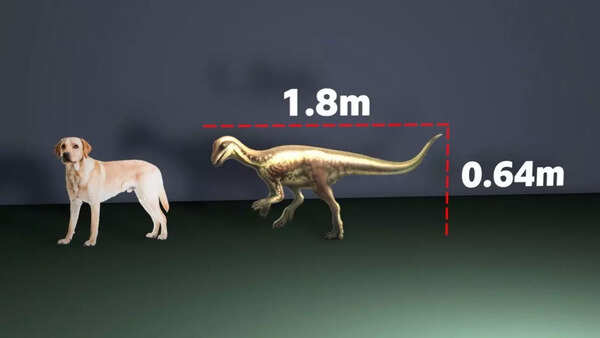Scientists have announced the discovery of a new dog-sized dinosaur species, offering a fascinating glimpse into the lives of smaller dinosaurs that roamed the Earth alongside giants. This find is significant for understanding the biodiversity of prehistoric ecosystems and how smaller dinosaurs managed to thrive in the shadow of their colossal relatives.

According to a report by The BBC, the new species, named Enigmacursor mollyborthwickae, was identified through a study published in the Royal Society Open Science journal. The dinosaur, about the size of a Labrador retriever with half its length attributed to its tail, was initially misclassified as a Nanosaurus. The distinct characteristics of this new dinosaur have led scientists to recognize it as a separate species. The fossil is currently exhibited at the Natural History Museum (NHM).
The Enigmacursor, meaning "puzzling runner," stood approximately 64 cm tall and 180 cm long. Despite its small size, especially when compared to contemporaries such as Stegosaurus, it thrived in its environment around 150 million years ago. Key features differentiating it from other dinosaurs included its relatively large feet and a notably long tail.

The reclassification occurred after scientists re-evaluated the original Nanosaurus specimen in the US. The original sample proved to be incomplete, consisting of a rock with mere bone impressions, which hindered definitive identification.
Despite its diminutive stature, the dog-sized dinosaur played an integral role in its prehistoric ecosystem. Its ability to coexist with both herbivorous and carnivorous giants demonstrates its adaptability and resilience. This finding underscores the complex dynamics of prehistoric life, challenging previous assumptions about dinosaur ecosystems.

The identification of Enigmacursor mollyborthwickae significantly enriches our understanding of dinosaur diversity, evolution, and behavior. It provides concrete evidence that smaller species not only survived but also played vital roles in ecosystems dominated by larger dinosaurs. This discovery contributes valuable data for ongoing research into deep-time evolutionary relationships and highlights the importance of re-evaluating existing fossil records with new analytical techniques.
Older articles
 Android Users Urged to Patch Devices Immediately Following Critical Security Flaws Alert
Android Users Urged to Patch Devices Immediately Following Critical Security Flaws Alert
 JPG to PDF: A Graphic Designer's Guide to Conversion & Best Practices
JPG to PDF: A Graphic Designer's Guide to Conversion & Best Practices
 Ashada Gupt Navratri 2025: Dates, Auspicious Timings, and Esoteric Significance Explained
Ashada Gupt Navratri 2025: Dates, Auspicious Timings, and Esoteric Significance Explained
 Suryakumar Yadav Undergoes Surgery for Sports Hernia: Examining the Injury, Recovery, and Risk Factors
Suryakumar Yadav Undergoes Surgery for Sports Hernia: Examining the Injury, Recovery, and Risk Factors
 Skin Cancer Alert: How to Identify Suspicious Moles and Early Warning Signs
Skin Cancer Alert: How to Identify Suspicious Moles and Early Warning Signs
 Samsung Galaxy A55 vs. Vivo V30 Pro: Premium Mid-Range Showdown
Samsung Galaxy A55 vs. Vivo V30 Pro: Premium Mid-Range Showdown
 iQoo Z9 Turbo: Leaked Specs Point to 1.5K Display, Snapdragon 8s Gen 3 & Massive Battery
iQoo Z9 Turbo: Leaked Specs Point to 1.5K Display, Snapdragon 8s Gen 3 & Massive Battery
 ChatGPT Service Disrupted Globally; OpenAI Confirms Restoration
ChatGPT Service Disrupted Globally; OpenAI Confirms Restoration
 IRCTC's AskDisha 2.0: AI Chatbot Streamlines Train Ticket Booking, Refunds, and Travel Information
IRCTC's AskDisha 2.0: AI Chatbot Streamlines Train Ticket Booking, Refunds, and Travel Information
 X Cracks Down: Over Half a Million Accounts Suspended in India for Policy Breaches
X Cracks Down: Over Half a Million Accounts Suspended in India for Policy Breaches